Japan’s Ministry of Defense (MoD) completed development of its first domestically designed supersonic anti-ship missile, designated XASM-3, with mass production of the new weapon system slated to begin in fiscal year 2019, according to local media reports.
The XASM-3 has been specifically designed to be carried by the Japan Air Self-Defense Force’s (JASDF) F-2 multirole fighter jets, a Mitsubishi license-produced variant of Lockheed Martin’s F-16. The service currently operates around 90 Mitsubishi F-2 multirole fighter aircraft, which first entered service in 2007.
“Each aircraft will be capable of carrying up to two XASM-3 missiles,” I noted July 2017. “The new missile will replace the older domestically produced Type 80 and Type 93 air-to-ship missiles capable of reaching near supersonic speed.” Powered by a ramjet engine, the missile can reportedly reach top speeds of up to Mach 3 and has an operational range of 80 nautical miles (150 kilometers.
In August 2017, Japan’s Acquisition Technology and Logistics Agency (ATLA) released for the first time footage showing the test firing of a XASM-3 missile. It is unclear, however, whether the missile was targeting a decommissioned Japan Maritime Self-Defense Force (JMSDF) destroyer, as was originally announced in 2016.
Development of the missile began in 2003. A first missile jettison test — used to validate the aerodynamic separation models of the missile — was conducted in March 2017, followed by user trials.
“The introduction of the new missile is aimed at keeping the Chinese Navy — which has been taking high-handed action in the East China Sea and other places — in check,” the Yomiuri Shimbun newspaper reported in 2017. As I noted last year, Japan has been trying to boost its anti-surface warfare capabilities by fielding new air and ground-launched anti-ship missile missiles:
(…) Japan is in the process of developing a new land-based anti-ship missile to reinforce the defenses of remote Japanese-controlled islets in the East China Sea. The new missile will have an approximate range of 300 kilometers use solid fuel, and is expected to be deployed by 2023.
The new missile will supplement the Type 12 subsonic anti-ship missile, an upgraded variant of the Mitsubishi Heavy Industries’ Type 88 surface-to-ship missile with a reported range of 200 kilometers (124 miles), currently in service with the Japan Ground Self-Defense Force (GSDF).
Japan is also slated to arm its new F-35A stealth fighter jets with the next-generation, long-range, precision-guided Joint Strike Missile (JSM), originally developed as an anti-ship missile. The new missile, with an estimated range of around 500 kilometers (310 miles), will become operational in 2025.
“Japan’s first line of defense against North Korean ballistic missiles is its six Aegis-equipped fleet of guided-missile destroyers,” I explained in December 2017. “According to Japan’s defense minister, the new missiles would specifically be purchased to defend these ships.”

































